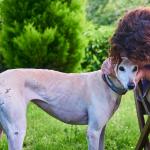Spanish Sighthound

The Spanish Sighthound, also known as the Galgo Español, is an ancient breed part of the Sighthound family. They are thought to be a descendants of the English Greyhound. Breeders have cross-bred Spanish Sighthounds and Greyhounds in order to produce faster and stronger Galgos. This is due to their famous participation in track racing. Unfortunately, race dogs are often mistreated and once they don't perform as well as demanded, they are left in adoption centres. This is why more families are adopting Galgos and helping them recover from the previous mistreatment.
If you're thinking of adopting a Spanish Sighthound, continue reading this breed file from AnimalWised to learn everything you need to know about this breed and how to care for them.
- Europe
- Spain
- Group X
- 5-14
- 14-18
- 18-22
- 22-27
- 27-31
- More than 31
- 2-7
- 7-22
- 22-55
- 55-100
- 100-220
- 8-10
- 10-12
- 12-14
- 15-20
- Low
- Meidum
- High
Origin
The origin of the Spanish Sighthound is not known with great certainty. Some theories suggest that the Ibizan Hound, participated in the development of the Galgo breed. Others, perhaps the majority, think that the Arabian Greyhound (Saluki) is one of the ancestors of the Spanish Sighthound. This theory states that the Arabian Greyhound was introduced to the Iberian Peninsula during the Arab conquest and that their crossing with local breeds produced the lineage that originated the Spanish Sighthound.
Although we can't know with certainty, what we do know is that the Spanish Sighthound was widely used for hunting during the Middle Ages. These dogs were so famous for hunting in Spain that they caused fascination in the aristocracy. They were even immortalized in the work "Hunting Party", also known as "Hunting the Quail", by the great Spanish painter Francisco Goya and Lucientes.
With the advent of Greyhound racing, the Spanish Sighthound was crossed with the Greyhound to produce faster dogs. The result of those crossings is known as Anglo-Spanish Greyhound and is not recognized by the FCI. Hunting with greyhounds is a very controversial activity in Spain, and many animal protection societies request that this activity be censored for the cruelty to which greyhounds are subjected.
Physical Appearance
Male Spanish Sighthounds reach a height at the withers of 24 to 27.5 inches, while females reach a height at the withers of 23.6 to 26.7 inches. The breed standard does not indicate a weight range for these dogs, but they are naturally light and agile dogs. The appearance of the Spanish Sighthound is very similar to the Greyhound, but Spanish Sighthounds are smaller in size. They have a slim body, an elongated head and a very long tail. They also have slim but powerful legs that allow them to be very fast.
Their body is well proportioned. Both their nose and lips are black. The eyes of the Spanish Sighthound are small, oblique and almond-shaped. They are usually dark colored. Their ears are set high. They are triangular, with a wide base and the end is rounded. Their long neck united their slim head and strong body. The Spanish Sighthound's chest is deep and their belly is really tucked up. Their back is slightly arched, giving flexibility to their spine.
The greyhound's tail is thick at the base and gradually thins to a very fine point. It is flexible and very long. Their skin is very close to the body on its entire surface, in other words, they do not have loose skin. The coat of the Spanish Sighthound is thick, fine, short and smooth. However, there is also a variety of hard and semi-long hair, in which beards, mustaches and eyebrows are formed on the face. Any coat color is accepted for these dogs, but dark brown, tan, yellow, red and white are very common.
Character
The Spanish Sighthound usually has a somewhat shy and reserved character, especially with strangers. For this reason, it is recommended to socialize them from a young age and continue to do so when they are adults. They are gentle, kind, sensitive and affectionate dogs. They are very tender with whom they trust.
Despite having a strong prey drive developed over generations, they are often friendly to small animals like cats and small breed dogs. That is why they are a good option for those who want to enjoy Galgos but also have other pets. This should also be worked on in their training and education.
Spanish Sighthounds have excellent behavior with children, adults and all kinds of people. They enjoy a relaxed atmosphere indoors but outside they become fast and active animals that will enjoy long walks and visits to the beach. It is important that the Spanish Sighthound is adopted by a proactive and loving family, which takes their submissive and noble character into account. Affection and exercise are two key factors when it comes to caring for a Spanish Sighthound.
Care
The Spanish Sighthound requires an active and positive family. They'll need between 2 to 3 walks per day. During these walks, it's advisable that they enjoy at least five minutes of freedom to run around without a leash. For this, you can go to a field or a fenced area to make sure they are safe. Playing games, such as catch, are very entertaining for this breed.
They will also appreciate being given intelligence games. These games will help relax them, give them mental stimulation and help in the over-all well being of the dog.
Spanish Sighthounds require to be brushed weekly. This is do to their short hair that doesn't tangle. Nevertheless, brushing will help to remove dead hair and show a shiny and glossy coat. Bathing these dogs are necessary only when they are really dirty.
Training and Education
The education of the Spanish Sighthound should always be based on positive reinforcement. They are very sensitive dogs so any type of punishment will cause great sadness and stress in the dog. Cruel punishment will also cause behavioral problems. Spanish Sighthounds are intelligent animals and have a great predisposition to learn new tricks when motivated with treats and affection. They also enjoy obedience training and canine sports.
When it comes to an adopted Galgo, their re-training will take some time as they have been mistreated in the past. To learn more about this, read our article on helping an abused dog. With this type of re-educating with positive reinforcement, you can help them overcome their fears and allow them to live a happier life.
Health
It's important to visit the veterinarian every 6 months for regular check-ups. This will help maintain your dog's health and prevent any arising issues. As for any other breed, you will need to keep up to date with their vaccination and deworming schedule. Another important factor to keep in mind is to feed your Spanish Sighthound in raised containers. This will prevent them from having to lower their long necks to ground level, which causes them pain.
This breed is relatively healthy, nevertheless, they are prone to some diseases that mainly affect large dogs. The most common for Spanish Sighthounds are:
- Bone cancer
- Gastric torsion
Spanish Sighthound photos














